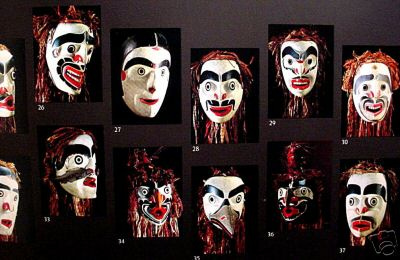Salishan
Groups who occupied the Pacific coast of what is now southern British Columbia and the interior regions as far east as the Rocky Mountains spoke Salishan languages, which include Squamish Salish, Lil'wat (Lillooet), Nl'akapamux or Ntlakyapamuk (Thompson), Okanagan, Chilcotin, and Interior Salish (Haklomelem). The language that was spoken by traders along the Pacific Coast and the interior territories was 'Chinook Jargon'.
Trade networks were extensive and certain male members of each village inherited or earned positions as traders. Along with the exchange of goods, cross-cultural exchanges occurred. Salishan speakers adopted the Pacific Coast peoples' belief in supernatural clan ancestors. They also adopted winter dances, in which participants wore animal masks, and the founding of secret spiritual societies. Despite their close trading ties with the Pacific Coast, the Interior Salish groups did not adopt a stratified class system. Rather, each small group of related families recognised the authority of a hereditary chief. An informal council of elders assisted him in his decision making. Hunting territory belonged to the group as a whole, but some families laid claim to specific fishing stations and berry-picking grounds.
Intermarriage allowed top families to maintain their position, and marriage was often used as a means of gaining rank on the social scale. Chastity was valued for women and the first menses for a girl was a cause for family celebration. A clan mother would hold a potlatch in her daughter's honour and the girl went into seclusion and learned skills from other female members of her family. Pubescent girls were secluded for lengthy periods until they reached the marriageable age of sixteen to eighteen years. Marriage customs involved the groom arriving at the bride's home at daybreak. He sat at the entrance to the house and was wrapped in a blanket with only his face exposed. The bride's family ignored him and proceeded with their daily routine. This ritual continued for three days. On the third day, if the bride's father approved of the match he invited the groom to breakfast. The groom's father is informed and the wedding ceremony was planned.
Winter was the season for religious ceremonies and celebrations. Religious mediums or shamans performed several rites, including magic against enemies. Both men and women served as shamans, acting in the capacity of spiritual intermediaries and healers. Illness was attributed to wandering souls or to foreign intrusions by an evil spirit. The skill of the shaman depended on his or her ability to rid the sick person of the evil spirit. The shaman presided over periodic fasts that required the participant to abstain from sexual relations and to scrub him or herself with branches in a cleansing ritual. Guardian spirits were prominent and were acquired by individuals during this period of fasting.
 Most tribes engaged in storytelling and dancing during the winter. Both the Lillooet and Shuswap held masked dances, re-enacting the guardian spirit's possession of a young man or woman who had embarked on a vision quest. The Interior Salish held a festival known as the Ghost Dance. This was celebrated whenever a group member claimed to have received a message from the land of ghosts. During the festival a series of dances and feasts was held, and a certain ritual activity was carried out each day. The morning was devoted to fasting and ritual cleansing, noon to feasting and prayers to the Chief of the Dead, and the afternoon to dancing. The evening was reserved for a smoking ceremony.
Most tribes engaged in storytelling and dancing during the winter. Both the Lillooet and Shuswap held masked dances, re-enacting the guardian spirit's possession of a young man or woman who had embarked on a vision quest. The Interior Salish held a festival known as the Ghost Dance. This was celebrated whenever a group member claimed to have received a message from the land of ghosts. During the festival a series of dances and feasts was held, and a certain ritual activity was carried out each day. The morning was devoted to fasting and ritual cleansing, noon to feasting and prayers to the Chief of the Dead, and the afternoon to dancing. The evening was reserved for a smoking ceremony.
Salishan speakers worshipped gods of the forest, mountain, and beach. They had an acute fear of sea monsters, ferocious birds that live in caves, or ogres of the forest. Religious belief systems were based upon the supernatural and natural world. While certain animal spirits were worshipped and feared, others, such as the salmon, were symbols of life and sustenance. The first salmon caught in the spring was symbolically viewed as representing all the salmon that would be caught in the annual harvest. This fish was sprinkled with red clay dust on an altar and was ceremoniously prepared. Everyone involved in the salmon harvest would have a piece of this fish, and its bones were returned to the water for reincarnation.